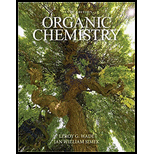
Concept explainers
Interpretation: The explanation of how the IR spectrum of the product differs from that of the reactant; and the approximate frequencies for distinctive peaks in the IR spectrum of the reactant and also of the product are to be given.
Concept introduction: An IR spectrum is a graph for the energy absorbed by a molecule as a function of the frequency or
To determine: The difference in the product and the reactant in the IR spectrum; and the approximate frequencies for distinctive peaks in the IR spectrum of the reactant and also of the product.
Want to see the full answer?
Check out a sample textbook solution
Chapter 12 Solutions
ORGANIC CHEMISTRY
- N-H bonds absorb IR radiation at very similar frequencies as O-H (alcohol) bonds. Oftentimes, they are not quite as large. Why?arrow_forwardPlease answer this question pertianing to organic chemistry.arrow_forwardExplain why these are the correct spectra for the molecules. Identify a specific absorption band which identifies each characteristic functional group of the molecule chosen.arrow_forward
- the quation is in the photoarrow_forwardWhy is this the correct spectra for these molecules. Identify a specific absorption band which identifies each characteristic functional group of the molecule chosen.arrow_forward8. A strong signal in infrared spectroscopy indicates that a molecule matches the emitted electromagnetic radiation and reports a high transmittance. True False 9. The signals observed from the C-C bond in an alkene will report at a higher wavenumber than the C-C bond in an alkyne. True False 10. The electronegativity difference present in a dipole moment within a bond is directly proportional to the electromagnetic field produced. True Falsearrow_forward
- In the warehouse of a chemical company there are 4 old reagents whose label can only be read that their formula is C4 H3 0. A chemist who works in the company has investigated in his inventory that they are the following compounds: OH Lon OH Compuesto A Compuesto B Compuesto C Compuesto D The chemist in question decides to obtain the IR spectra of each of the compounds. Identify each of the above compounds with their respective infrared spectrum Choose. Spectrum 4 Choose. Spectrum 3 Choose.arrow_forwardThe C=C bond in 2-cyclohexenone (shown below) produces an unusually strong signal. Explain using resonance structures. 14.06a1 Which of the following explains why the C=Cond in 2-cyclohexenone produces an unusually strong signal. O Conjugation with the C=O results in resonance, giving the C=C bond some single bond character (making it weaker). Conjugation with the C=O results in resonance, making the C=C bond more polar than usual. O Conjugation with the C=O results in resonance, making the C=C bond less polar than usual. O Conjugation with the C=O results in resonance, giving the C=C bond some single bond character (making it stronger).arrow_forwardDraw structures for the three isomers 1-butyne, 1,3-butadiene, and 2-butyne. Explain how you would distinguish these compounds using IR spectroscopy. Give specific examples of peaks that would illustrate the differences.arrow_forward
- Why do aldehydes, esters, and amides all have a strong absorption in the 1630-1780 cm1 region of their IR spectra? A) The bond between H and the sp³-hybridized C in these functional groups vibrates in this energy range. B) Each of these functional groups has at least two resonance structures, and the different vibrations of the resonance structures give off energy in this region. C) The bond between O and the sp²-hybridized C in these functional groups vibrates at a frequency in this energy range. D) Light at this wavenumber causes the average C to O bond length to increase which causes more of this light to be transmitted. E) An electron in the bond of these functional groups gets excited to the * orbital.arrow_forwardAnalyze the 1H NMR of 2-phenyl-2-propanol. Based on intensities and splitting patterns, it should be possible to assign all of the peaks in this spectrum. Analyze the 1H NMR of 2-cyclohexyl-2-propanol. In this case, it is not possible to assign all peaks. Indicate which peaks can be assigned to specific H atoms in this compound.arrow_forwardA common lab experiment is the dehydration of cyclohexanol to cyclohexene.(a) Explain how you could tell from the IR spectrum whether your product was pure cyclohexene, pure cyclohexanol,or a mixture of cyclohexene and cyclohexanol. Give approximate frequencies for distinctive peaks.arrow_forward
 Organic Chemistry: A Guided InquiryChemistryISBN:9780618974122Author:Andrei StraumanisPublisher:Cengage Learning
Organic Chemistry: A Guided InquiryChemistryISBN:9780618974122Author:Andrei StraumanisPublisher:Cengage Learning
